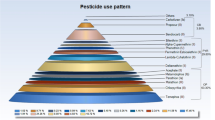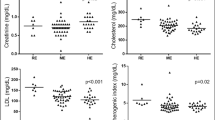Abstract
Ninety-seven agricultural workers were monitored for absorption of the organophosphorus pesticides methidathion, vamidothion, and azinphos-methyl, which were sprayed in an orchard during two seasons. Low levels of only one dialkylphosphorus metabolite (dimethyl phosphorothioate) were found in only eight workers in pre-exposure urine samples. More than one dialkylphosphorus metabolite was detected in almost all exposed individuals in after-exposure urine samples. The highest concentrations were measured after exposure to azinphos-methyl; the median concentrations of dimethyl phosphorodithioate and dimethyl phosphorothioate were 0.92 and 0.78 nmol/mg creatinine with a concentration range up to 14.3 and 53.7, respectively. Three diethylphosphorus metabolites were also detected in some samples, but at lower concentrations. Cholinesterase activities were decreased (31–48%) in the serum of 12 workers; four of those workers had no dialkylphosphorus metabolites in the urine. Paraoxonase and arylesterase activities in the serum were unaffected by the absorption of pesticides, and there was no correlation between the activities of these esterases and the metabolite concentrations in the urine. This study confirmed that dialkylphosphorus metabolites in the urine are a more sensitive index of absorption than cholinesterase inhibition in the serum but lack of correlation between cholinesterase inhibition and metabolite concentration indicates that both parameters should be monitored.
Similar content being viewed by others
References
Alessio L, Berlin A, Dell'Orto A, Toffoletto F, Ghezzi I (1985) Reliability of urinary creatinine as a parameter used to adjust values of urinary biological indicators. Int Arch Occup Environ Health 55:99–106
Bartels H, Böhmer M (1971) Eine Mikromethode zur Kreatininbestimmung. Clin Chim Acta 32:81–85
Blair D, Roderick HR (1976) An improved method for the determination of urinary dimethyl phosphate. J Agric Food Chem 24:1221–1223
Cain K, Reiner E, Williams DG (1983) The identification and characterization of two separate carboxylesterases in guinea-pig serum. Biochem J 215:91–99
Drevenkar V, Fröbe Z, Vasilic Z, Tkalčević B, Štefanac Z (1979) The rate of urinary excretion of Phosalone residues in occupationally exposed persons. Sci Total Environ 13:235–243
Duncan RC, Griffith J (1985) Monitoring study of urinary metabolites and selected symptomatology among Florida citrus workers. J Toxicol Environ Health 16:509–521
Ellman GL, Courtney KD, Andres V, Featherstone RM (1961) A new and rapid colorimetric determination of acetylcholinesterase activity. Biochem Pharmacol 7:88–95
Enzyme Nomenclature (1989) Recommendations of the Nomenclature Committee of the International Union of Biochemistry. Supplement 2. Eur J Biochem 179:489–533
Franklin CA, Fenske RA, Greenhalgh R, Mathieu L, Denley HV, Leffingwell JT, Spear RC (1981) Correlation of urinary pesticide metabolite excretion with estimated dermal contact in the course of occupational exposure to Guthion. J Toxicol Environ Health 7:715–731
Franklin CA, Muir NI, Moody RP (1986) The use of biological monitoring in the estimation of exposure during the application of pesticides. Toxicol Lett 33:127–136
Geldmacher-v. Mallinckrodt M, Diepgen TL (1988) The human serum paraoxonase polymorphism and specificity. Toxicol Environ Chem 18:79–196
Knaak JB, Maddy KT, Khalifa S (1979) Alkyl phosphate metabolite levels in the urine of field workers giving blood for cholinesterase test in California. Bull Environ Contam Toxicol 21:375:380
Kummer R, Van Sittert NJ (1986) Field studies on health effects from the application of two organophosphorus insecticide formulations by hand-held ULV to cotton. Toxicol Lett 33:7–24
Reiner E, Aldridge WN, Hoskin FCG (eds.) (1989a) Enzymes hydrolyzing organophosphorus compounds. Ellis Horwood Publishers, Chichester, pp 1–266
Reiner E, Radić Z, Simeon V (1989b) Hydrolysis of paraoxon and phenylacetate by human serum esterases. In: Reiner E, Aldridge WN, Hoskin FCG (eds) Enzymes hydrolyzing organophosphorus compounds. Ellis Horwood Publishers, Chichester, pp 30–40
Vasilic Z, Drevenkar V, Fröbe Z, Stengl B, Tkalcevic B (1987) The metabolites of organophosphorus pesticides in urine as an indicator of occupational exposure. Toxicol Environ Chem 14:111–127
Vogel AI (1956) Practical Organic Chemistry. Longmans, Green, New York, p 971
World Health Organization, Copenhagen (1987) Organophosphorus pesticides: an epidemiological study. Environmental Health Series 22:5–14
—, Geneva (1990) Principles for the toxicological assessment of pesticide residues in food. Environmental Health Criteria 104:63–65
Author information
Authors and Affiliations
Rights and permissions
About this article
Cite this article
Drevenkar, V., Radić, Z., Vasilić, Ž. et al. Dialkylphosphorus metabolites in the urine and activities of esterases in the serum as biochemical indices for human absorption of organophosphorus pesticides. Arch. Environ. Contam. Toxicol. 20, 417–422 (1991). https://doi.org/10.1007/BF01064413
Received:
Revised:
Issue Date:
DOI: https://doi.org/10.1007/BF01064413




